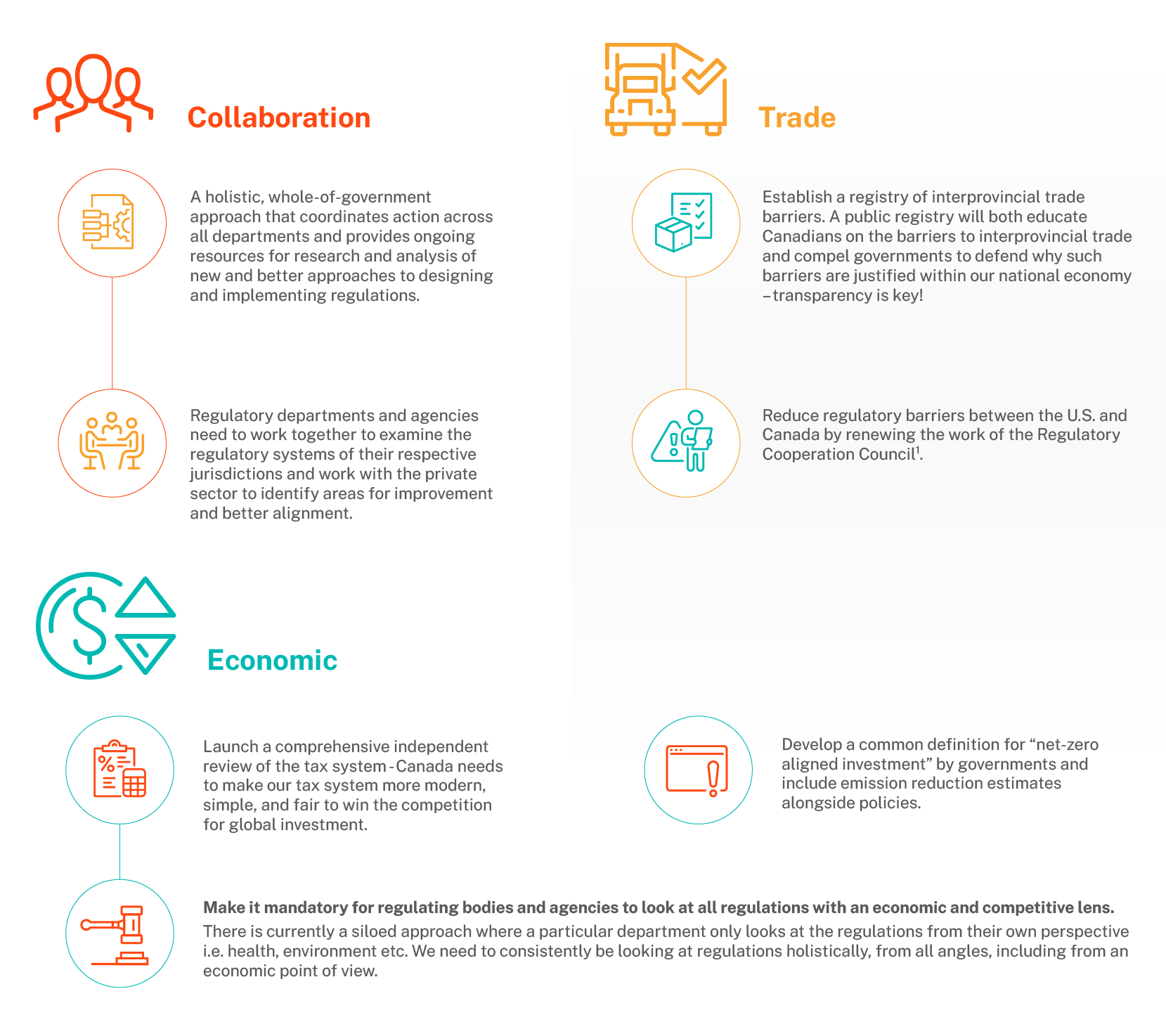Blog /
Policy Matters: Regulatory Reform
Policy Matters: Regulatory Reform
We talk a lot about regulatory burden here at the Canadian Chamber because it is consistently one of the biggest barriers to economic growth that we see across sectors.


We talk a lot about regulatory burden here at the Canadian Chamber of Commerce because it is consistently one of the biggest barriers to economic growth that we see across sectors.
So, what *IS* it exactly?
In a Nutshell
“Regulations” are the government rules that legally dictate what businesses are allowed to do when it comes to producing, manufacturing and selling their goods and services.
The OECD lists three general types:
- Economic regulation is meant to improve the efficiency of delivering goods and services to markets and customers. It can include government-imposed restrictions on things like prices, quantity, service and imports and exports.
- Social regulation is meant to protect the well-being and rights of society. It can include protection of the environment, health and safety in the workplace, workers’ rights, and consumer protections against things like fraud.
- Administrative regulation relates to general government management of the operation of the public and private sectors. It can include regulations relating to taxes, business operations, distribution systems, health care administration and intellectual property rights.

THE POLICY PROBLEM
Well-designed and well-implemented regulations can be one of the government’s tools to grow the economy and help keep Canadian citizens and our environment safe.
Unfortunately, Canada has a complex network of overlapping regulations from all levels of government that make a lot of things more expensive and difficult than they need to be for businesses.
Complying with all these layers of regulations is also time-consuming, and combined with inefficient and unpredictable regulatory processes, Canadian businesses are not set up for success. Every hour and every dollar spent dealing with redundant paperwork and confusing compliance issues is an hour or dollar not spent on running and growing a business. This is especially true for small businesses, which often lack the specialized staff and financial resources of larger companies to deal with regulation and compliance.
Let’s look at a few examples of how regulatory burdens can impact the economy:

Transportation
The approval process for trade-enabling transportation infrastructure projects can take upwards of 10 years due to inefficient regulatory processes. By stalling on the approvals that would put shovels in the ground on projects like twinning railways, increasing bridge capacity and modernizing shipping ports, Canada and Canadian businesses lose out on billions in annual revenue. We need to be able to get things like food, fuel, fertilizer and critical minerals to domestic manufacturers, ports and international markets. If we can’t move Canadian goods, we can’t sell them, and that’s bad news for everyone.

Net-zero
A predictable, consistent regulatory framework is crucial for Canada to hit its net-zero targets. Key words – “predictable” and “consistent”. The transition to net-zero can’t happen overnight and businesses need time to prepare, make the necessary investments and gradually adjust their operations. Unfortunately, Canada’s convoluted, shifting goal posts and regulations make long-term business planning extremely challenging. This uncertainty also impacts our ability to attract the kinds of global investments we need for our natural resources sector to help develop clean fuels like natural gas, hydrogen and sustainable biofuels. We need to convince investors that Canada is a safe bet – the uncertainty around net-zero regulations is doing anything but.

Interprovincial Trade
Nearly 25% of businesses who trade interprovincially cite red tape as a major obstacle to doing business within Canada. Over decades of regulation making, provinces and territories have introduced differing rules and standards that impact nearly every sector. They affect areas like trucking and transportation standards, food packaging and labelling standards, professional certifications and securities regulation. As a result, businesses have to deal with different sets of rules and processes in each province, and for many, this causes serious barriers to business or opting out of interprovincial trade all together – this reduces Canada’s GDP by billions of dollars every year.

Talent & the Workforce
In a global economy, regulatory burdens are especially problematic. The more red tape a business runs into in any given country, the less likely they are to stay– they can take their business and job opportunities elsewhere. And where the opportunities go, so too does the talent. Canada is at risk of losing not just businesses, but the next generation of talented and innovative workers to other countries.

Canada and the United States
The United States is our primary ally and trading partner – a huge amount of goods come and go across the border every day – which makes regulatory differences between the two countries especially problematic. Different rules or processes create unnecessary supply-chain slow-downs and add costs for exporting companies. We also compete with the United States for investment. We want companies to open headquarters here, create jobs for Canadians and contribute to our economy – but when they can do that at a cheaper price tag and with less of a headache south of the border due to more business-friendly regulations, all Canadians lose.

POLICY SOLUTION
Considering Canada’s alarmingly low level of economic growth – our GDP is projected to grow by only 1.4% this year and 1.3% in 2024 – we literally can’t afford the regulatory burdens facing Canadian businesses. The solution?
Regulatory reform (aka regulatory modernization).
A modern, streamlined regulatory process is a thing of beauty, removing barriers and allowing businesses to stay competitive and maximize their growth while protecting the welfare of Canadian citizens. This looks like improved environmental, social and economic protections, while simultaneously increasing investment growth and the number of jobs for Canadians – win-win!
We can’t just talk the talk when it comes to regulatory reform – we need to see real action that will move the needle. How do we do it? We’ve got lots of ideas – here are just a few:


WHAT’S NEXT?
Concerned about regulatory burdens and want to know how your business can act? Here are a few ways to get involved:
- Write or request a meeting with your federal MP(s) or provincial/territorial government representative to voice your concerns if your business is being impacted by regulatory burdens.
- Consider joining your local chamber of commerce or board of trade. By joining, you can add your voice to the development of policy and advocacy positions that drive business success. Simply Google your town/city + “chamber of commerce” or “board of trade” to find your local chamber or visit our membership page.

RESOURCES
Our Government Recommendations
Learn More
Other Blogs

Policy Matters: Revisiting the 3 Most Popular Topics of the Year

Vaccines: A Potential Key to Unlock Many of Canada’s Healthcare Challenges




